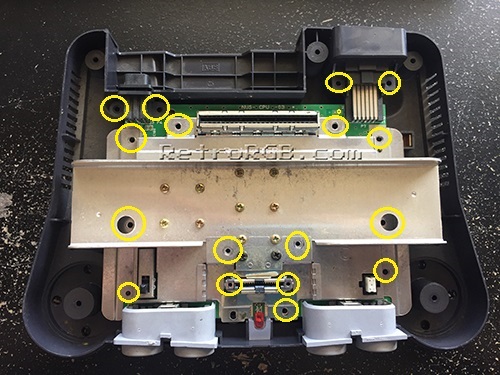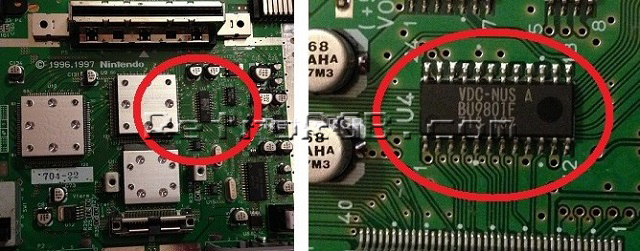N64:RGB-Compatible Systems: Difference between revisions
No edit summary |
mNo edit summary |
||
| (5 intermediate revisions by 2 users not shown) | |||
| Line 1: | Line 1: | ||
[[Category:N64]] | [[Category:N64]] | ||
All versions of the N64 can be RGB and HDMI modded. The [[N64:UltraHDMI_(HDMI)|UltraHDMI Board]] works with all versions of the N64, however there are a few choices for RGB. | |||
== Compatible with all N64s == | |||
== Compatible with all | |||
<small>'''Every N64 can output RGB using a more complicated RGB kit, which are generally more expensive and harder to install, but offer extra features:'''</small> | <small>'''Every N64 can output RGB using a more complicated RGB kit, which are generally more expensive and harder to install, but offer extra features:'''</small> | ||
:Tim Worthington sells an excellent kit that's compatible with all | :Tim Worthington sells an excellent kit that's compatible with all N64s and can be purchased directly from his store: | ||
::*Tim's N64RGB: [http://etim.net.au/shop/shop.php?crn=209&rn=548&action=show_detail http://etim.net.au/shop/shop.php?crn=209&rn=548&action=show_detail] | ::*Tim's N64RGB: [http://etim.net.au/shop/shop.php?crn=209&rn=548&action=show_detail http://etim.net.au/shop/shop.php?crn=209&rn=548&action=show_detail] | ||
| Line 15: | Line 12: | ||
:Borti has released ''two'' designs for an N64RGB solution!: | :Borti has released ''two'' designs for an N64RGB solution!: | ||
::#A 'general' RGB-output kit, plus a more advanced kit that can output component video ''and'' VGA. - [https://8bitmods.com/nintendo-64-rgb-v2-0/ 8BitMods(US)] | ::#A 'general' RGB-output kit, plus a more advanced kit that can output component video ''and'' VGA. - [https://8bitmods.com/nintendo-64-rgb-v2-0/ 8BitMods(US)] | ||
::#An advanced kit that can also linedouble to 480p | ::#An advanced kit that can also linedouble to 480p as well as output standard RGB. - [https://retrogamerstuff.com/collections/nintendo-64/products/n64-advanced-rgb-mod? RetroGamerStuff(US)] | [https://8bitmods.com/n64-rgb-advanced/ 8BitMods (US)] | ||
::#Open Source Files - [https://github.com/borti4938/n64rgb GitHub] | ::#Open Source Files - [https://github.com/borti4938/n64rgb GitHub] | ||
:<small>'''Borti also released custom firmware that allows for "de-blur" options. This firmware will work on both his and Tim's kits | :<small>'''Borti also released custom firmware [[N64:N64blur|that allows for "de-blur" options.]] This firmware will work on both his and Tim's kits.'''</small> | ||
== Only compatible with early N64s == | |||
== Only compatible with early | <small>'''Early versions of the N64 (the first 4 board revisions) can output RGB with a board that offers the same video quality, but are _much_ easier to install and less expensive. There are a few tricks to find compatible N64s, but the only way to be 100% sure is by opening it up.'''</small> | ||
<small>'''Early versions of the N64 (the first 4 board revisions) can output RGB with a board that offers the same video quality, but are _much_ easier to install and less expensive. There are a few tricks to find compatible | |||
====How to find RGB-outputting NTSC N64 Systems==== | ====How to find RGB-outputting NTSC N64 Systems==== | ||
:#If you have a serial number that starts with "NS1" (USA), "NUJ1" (Japan) or French systems with the model number "NUS-001(FRA)", then you most likely have an N64 that's compatible. Supposedly, some early Canadian | :#If you have a serial number that starts with "NS1" (USA), "NUJ1" (Japan) or French systems with the model number "NUS-001(FRA)", then you most likely have an N64 that's compatible. Supposedly, some early Canadian N64s also contain this chip. | ||
:#Many older Brazilian | :#Many older Brazilian N64s can also be RGB modded. Even though Brazil used PAL-M, it was still 60 Hz and only compatible with NTSC games: [http://s9.zetaboards.com/Nintendo_64_Forever/topic/7405289/1/ http://s9.zetaboards.com/Nintendo\_64\_Forever/topic/7405289/1/] | ||
:#If you have a serial number that starts with anything else, or is a PAL console, you'll need to use the "advanced" kits described above. | :#If you have a serial number that starts with anything else, or is a PAL console, you'll need to use the "advanced" kits described above. | ||
:#For more information on which serial numbers have each motherboard revision, please visit these sites: [http://forums.modretro.com/viewtopic.php?f=33&t=1417 http://forums.modretro.com/viewtopic.php?f=33&t=1417] / | :#For more information on which serial numbers have each motherboard revision, please visit these sites: [http://forums.modretro.com/viewtopic.php?f=33&t=1417 http://forums.modretro.com/viewtopic.php?f=33&t=1417] / | ||
| Line 34: | Line 30: | ||
====Confirming the correct chip==== | ====Confirming the correct chip==== | ||
<small>'''Regardless of serial number, please open your N64 to double check that it has the correct video chip that's required for RGB-modding (explained below). To open the system, you'll simply need a 4. | <small>'''Regardless of serial number, please open your N64 to double check that it has the correct video chip that's required for RGB-modding (explained below). To open the system, you'll simply need a 4.5 mm gamebit driver and a Phillips/JIS screwdriver, as described in the [[N64:Repair Tools|Repair Tools]] page.'''</small> | ||
::1. Remove the | ::1. Remove the Jumper Pak or Expansion Pak, then remove the six 4.5 mm gamebit screws holding the shell together. | ||
::2. | ::2. With the top case removed, unscrew only the screws that are circled in the picture below: | ||
[[File:N64ShieldRemoval.jpg|center]] | [[File:N64ShieldRemoval.jpg|center]] | ||
::3. After removing | ::3. After removing these screws, the entire metal heat sink and RF shield will lift off as one piece, exposing the motherboard: | ||
::4. Once | ::4. Once the console is disassembled, look for the following chip. | ||
| Line 54: | Line 50: | ||
==Where to purchase | ==Where to purchase== | ||
If your N64 is compatible with a basic mod, you can either make your own RGB amp board, or buy one pre-assembled. The pre-assembled ones are recommended, as they generally use better amp chips (THS7374 vs 7314) and some offer more features like a sync stripper. | If your N64 is compatible with a basic mod, you can either [[N64:RGB_Mod_DIY_RGB_Amp|make your own RGB amp board]], or buy [[N64:RGB_Mod_Basic_Amp_Install|one pre-assembled]]. The pre-assembled ones are recommended, as they generally use better amp chips (THS7374 vs 7314) and some offer more features like a sync stripper. | ||
Latest revision as of 04:23, 8 December 2022
All versions of the N64 can be RGB and HDMI modded. The UltraHDMI Board works with all versions of the N64, however there are a few choices for RGB.
Compatible with all N64s
Every N64 can output RGB using a more complicated RGB kit, which are generally more expensive and harder to install, but offer extra features:
- Tim Worthington sells an excellent kit that's compatible with all N64s and can be purchased directly from his store:
- Tim's N64RGB: http://etim.net.au/shop/shop.php?crn=209&rn=548&action=show_detail
- Installation guide: http://etim.net.au/n64rgb/instructions-new/
- Borti has released two designs for an N64RGB solution!:
- A 'general' RGB-output kit, plus a more advanced kit that can output component video and VGA. - 8BitMods(US)
- An advanced kit that can also linedouble to 480p as well as output standard RGB. - RetroGamerStuff(US) | 8BitMods (US)
- Open Source Files - GitHub
- Borti also released custom firmware that allows for "de-blur" options. This firmware will work on both his and Tim's kits.
Only compatible with early N64s
Early versions of the N64 (the first 4 board revisions) can output RGB with a board that offers the same video quality, but are _much_ easier to install and less expensive. There are a few tricks to find compatible N64s, but the only way to be 100% sure is by opening it up.
How to find RGB-outputting NTSC N64 Systems
- If you have a serial number that starts with "NS1" (USA), "NUJ1" (Japan) or French systems with the model number "NUS-001(FRA)", then you most likely have an N64 that's compatible. Supposedly, some early Canadian N64s also contain this chip.
- Many older Brazilian N64s can also be RGB modded. Even though Brazil used PAL-M, it was still 60 Hz and only compatible with NTSC games: http://s9.zetaboards.com/Nintendo\_64\_Forever/topic/7405289/1/
- If you have a serial number that starts with anything else, or is a PAL console, you'll need to use the "advanced" kits described above.
- For more information on which serial numbers have each motherboard revision, please visit these sites: http://forums.modretro.com/viewtopic.php?f=33&t=1417 /
Confirming the correct chip
Regardless of serial number, please open your N64 to double check that it has the correct video chip that's required for RGB-modding (explained below). To open the system, you'll simply need a 4.5 mm gamebit driver and a Phillips/JIS screwdriver, as described in the Repair Tools page.
- 1. Remove the Jumper Pak or Expansion Pak, then remove the six 4.5 mm gamebit screws holding the shell together.
- 2. With the top case removed, unscrew only the screws that are circled in the picture below:
- 3. After removing these screws, the entire metal heat sink and RF shield will lift off as one piece, exposing the motherboard:
- 4. Once the console is disassembled, look for the following chip.
- 5. If it says "VDC-NUS" or "VDC-NUS A" (like pictured below), you should be fine and can proceed with the basic RGB mod.
- If it doesn't have this chip, you'll have to use one of the advanced mods.
- 5. If it says "VDC-NUS" or "VDC-NUS A" (like pictured below), you should be fine and can proceed with the basic RGB mod.
Where to purchase
If your N64 is compatible with a basic mod, you can either make your own RGB amp board, or buy one pre-assembled. The pre-assembled ones are recommended, as they generally use better amp chips (THS7374 vs 7314) and some offer more features like a sync stripper.

